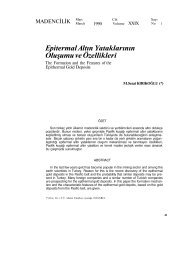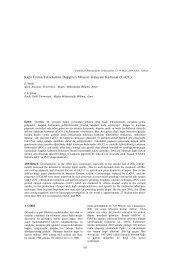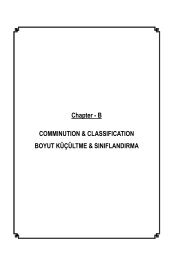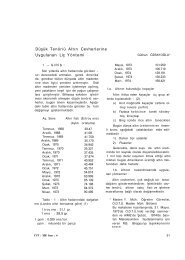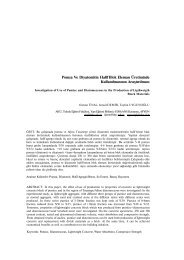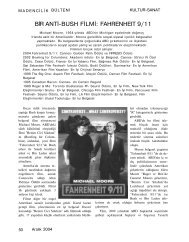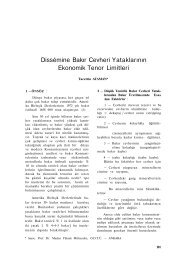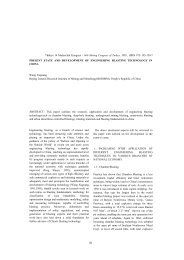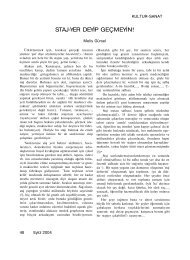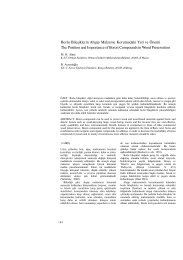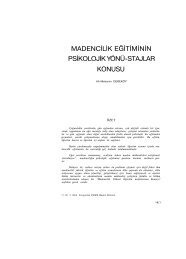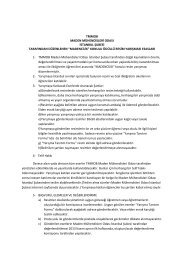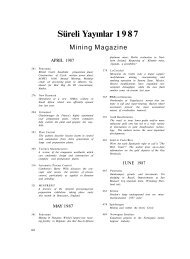A OPEN PIT MINING AÇIK OCAK MADENCİLİĞİ
A OPEN PIT MINING AÇIK OCAK MADENCİLİĞİ
A OPEN PIT MINING AÇIK OCAK MADENCİLİĞİ
Create successful ePaper yourself
Turn your PDF publications into a flip-book with our unique Google optimized e-Paper software.
1 INTRUDUCTION<br />
The study area is located in the central<br />
part of sanandaj- sirjan metamorphic zone<br />
This zone has a great potential of<br />
hydrothermal deposits such as Agdarreh<br />
(gold), Zarshouran (gold) and Angouran<br />
(mixed sulphide–nonsulphide zinc) (Figure<br />
1). Most of the known deposits exhibit a<br />
well-developed zonal pattern of<br />
mineralization and wallrock alteration that<br />
can be defined by broad variations in major<br />
oxides and trace element concentrations.<br />
These elemental compositions in turn reflect<br />
variations in mineralogical composition of<br />
the altered zones. Most of the hydrothermal<br />
alteration processes produce clay and other<br />
silicate minerals (e.g. argillic and phyllic<br />
zones). Supergene alteration results in the<br />
formation of extensive iron oxide minerals,<br />
giving characteristic yellowish or reddish<br />
color to the altered rocks. These alteration<br />
minerals can be detected by remote sensing<br />
techniques (Abrams et al., 1984; Elvidge &<br />
Lyon, 1984; Amos & Greenbaum, 1989;<br />
Drury & Hunt, 1989).<br />
ASTER data has been used to locate areas<br />
of iron oxides and/or hydrous minerals which<br />
might be associated with hydrothermal<br />
alteration zones. The host rocks that contain<br />
ore deposits of hydrothermal origin always<br />
show the result of interaction with the<br />
hydrothermal fluids that change the mineral<br />
and chemical composition of the rock and<br />
cause the deposition of the ore and related<br />
hydrothermal minerals (Rutz-Armenta &<br />
Prol-Ledesma, 1998).<br />
Aster Image dataset (Terra satellite) with<br />
having suitable spatial and spectral<br />
resolution, has a significant impact on<br />
geological and exploration studies. This<br />
dataset, with suitable spectral resolution in<br />
infrared reflection range -that most minerals<br />
are having absorption spectral charts in it -<br />
provides the possibility of detachment<br />
various alteration types. In addition, In<br />
addition, this sensor having five spectral<br />
bands in the thermal infrared range is<br />
considered a Multi thermal sensor that can<br />
separate Lithological units in this way.<br />
Aster images are classified in 14-band.<br />
The features of sensor images include:<br />
- Visible Near Infrared images (VNIR) with<br />
a ground resolution of 15 meters (3 bands).<br />
- Short Wave Infrared images (SWIR) with a<br />
ground resolution of 30 meters (6 bands).<br />
- Thermal Infrared images (TIR) with 90 m<br />
ground resolution (5 bands) (Fig. 1).<br />
Figure 1. ASTER spectral bands and their<br />
classifications.<br />
In this project, we used the ASTER<br />
images in various band combinations for<br />
extracting geological structures (faults and<br />
lineaments), rock unit types and alteration<br />
associated with gold mineralization.<br />
2 GEOLOGICAL SETTING OF<br />
DARREHASHKI GOLD DEPOSITE<br />
Darehashki gold deposit is located in 55<br />
Km of eastern Golpayegan city, central Iran<br />
(Fig 2). The deposit in one of gold deposits<br />
of occurred in Muteh complex. The complex<br />
were occurred in Sanandaj-Sirjan structuralmetamorphic<br />
zone which has 1500 Km long<br />
and 150 to 200 Km. The Sanandaj-Sirjan<br />
zone related to the creation of the Tethys<br />
ocean and its subsequent destruction during<br />
Cretaceous and Tertiary convergence and<br />
continental collision between the Afro-<br />
Arabian and the Eurasian platesMohajjel et<br />
al., 2003; Agard et al., 2005; Ghasemi &<br />
Talbot 2006; Moritz et al., 2006; Daliran,<br />
2008). The complexly deformed subzone of<br />
the Sanandaj-Sirjan zone, which hosts the<br />
Muteh gold deposits, is distinguished by<br />
abundant greenschist and amphibolite facies<br />
metamorphic rocks (Mohajjel et al., 2003).<br />
Mesozoic and Tertiary sedimentary rocks<br />
overlying Paleozoic sedimentary rocks<br />
predominate in the Muteh complex and are<br />
178



